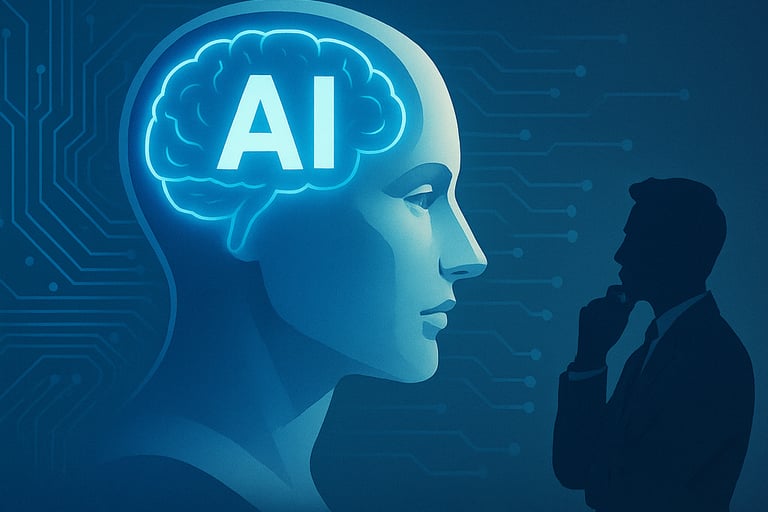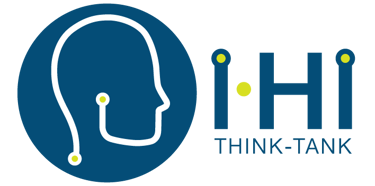News from Artificial Intelligence: Present, Challenges, and Future
In recent years, artificial intelligence (AI) has grown from a quiet technological revolution into a topic that concerns everyone – from ordinary citizens, through business leaders, to state policies. Some may say that AI is just another trend; some analysts claim that AI, the dialogue, and the excitement around it are overhyped, while others warn that it is underhyped. Yet, it is enough to look at what the leading companies in the world are doing to see that this is a fundamental change in the way we live, work, and think.
By: Valentin Neshovski / 15.10.2025
In recent years, artificial intelligence (AI) has grown from a quiet technological revolution into a topic that concerns everyone – from ordinary citizens, through business leaders, to state policies.
Some may say that AI is just another trend; some analysts claim that AI, the dialogue, and the excitement around it are overhyped, while others warn that it is underhyped. Yet, it is enough to look at what the leading companies in the world are doing to see that this is a fundamental change in the way we live, work, and think.


For example, as noted by author Andrew W. Pearson in his blog “AI — The Hype of All Hypes?” (August 2025), under the subtitle “Overhyped, Oversold, Overpromised… Is AI flaming out or speed bumping?”, the public discourse increasingly raises the question of whether artificial intelligence is truly a revolution — or just another technological bubble waiting to burst.
In contrast, Eric Schmidt, former CEO of Google, and others argue exactly the opposite. In his 2025 TED Talk titled “The AI Revolution is Underhyped”, Schmidt emphasizes that the real transformation is yet to come — that AI is not overestimated, but rather deeply underestimated, since its scope of influence will be far wider than current predictions.
Schmidt is practically on a world tour, and in various appearances warns that dramatic changes are coming, of which people are unaware, and that major corporations should slow down and even pause — speaking of the expected strong tremors from the coming General Artificial Intelligence (AGI).
That is why this text is not just an overview of the latest achievements, but also an attempt to explain what they mean — especially for those encountering the topic for the first time. The text concludes with recommendations for the Balkan countries, aligned with the Позицискиот документ на И-Хи Тинк-тенк
Benefits of AI – and Dangers
What good can AI bring us?
Benefits of AI
When we talk about the benefits of AI, many people immediately think of robots and automation — but the benefits are far broader.
New materials and science
AI can accelerate discoveries in physics, chemistry, and biology — models can predict molecules, materials with new properties, and shorten the period from idea to experimental verification.Medicine and healthcare
Generative models already help design new molecules, identify potential drugs, and predict side effects. This means faster discoveries, cheaper research, and therapies tailored to the patient.Increased productivity
In the business world, AI can take over routine tasks (reviews, sorting, analyses), assist in writing documents, provide suggestions, and optimize processes. Thus, people can focus on creative, strategic work.
But the dangers are no smaller:
Loss of jobs
The most exposed are routine administrative jobs, employees in support centers, and white-collar positions that depend on information processing (financial services, banking, insurance). It’s not that all will disappear, but they will be strongly transformed.
According to McKinsey estimates, by 2030 automation could “wipe out” hundreds of millions of jobs.
sevenpillarsinstitute-org.sevenpillarsconsulting.comFake news, manipulations, disinformation
AI models can generate convincing text, video, and audio — which means that malicious actors can more easily spread fake news, deepfake clips, and manipulations. This endangers public discourse, media trust, and the stability of democracy.Transformative power
It’s not just about technology — it’s about reorganizing systems: education, healthcare, infrastructure.
Countries that experience these transformations earlier may gain enormous competitive advantage; those left behind may face a widening gap.
How Will AI Affect the Economy and Work?
This is the question that worries ordinary people the most.
Will my job remain? Will the machine replace me?
According to the International Monetary Fund (IMF) and the World Bank:
Up to 40% of jobs are at risk of automation.
Particularly vulnerable are administrative workers, technical support staff, drivers, and even some healthcare services.
However, new opportunities are also emerging:
Training for AI system management,
AI ethics,
Digital analysis,
New industries that do not exist today.
The main challenge will be requalification – how to prepare people for the future.
In the following table, we show how AI affects certain fields, comparing traditional and AI-driven work processes.
In the following table, projections are presented (comparisons prepared with the help of ChatGPT-5, to which we provided sources from the World Economic Forum, 2023; IMF, 2024; McKinsey Global Institute, 2023; and OECD Employment Outlook, 2023) on the impact on the labor force by sectors.
The Latest AI Achievements by Company
The “Big Five” on the market — OpenAI, Google DeepMind, Meta, Anthropic, and xAI — are engaged in an intense race to advance AI and attract as many users and companies as possible. In the past two weeks alone, dozens of new products have been released.
OpenAI
OpenAI is the company behind ChatGPT — probably the most well-known AI product in the world today. But behind this platform lies much more innovation.
GPT-4 Turbo Agents: A personal assistant that not only understands what you say but learns from you over time, performs tasks independently, and communicates with other virtual assistants. These are GPT-4 agents — digital “workers” that can save you time and energy. Some of the simplest demonstrated autonomous tasks include reserving and paying (with your permission) for opera or sports tickets, or ordering food.
Sora 2: This model has sparked enormous interest worldwide. It’s a new generative model that can create video content from a simple text description. For example, if you write “a dog running on the beach at sunset,” Sora 2 can generate a realistic video of that scene. This kind of tool will be used in film production, marketing, and education.
Google (DeepMind)
Through its AI subsidiary DeepMind, Google has positioned itself as a leader in science-oriented AI.
Gemini 1.5 Ultra: Capable of processing long texts (“long context”). This model can “remember” much longer conversations and documents, making it excellent for complex tasks — supporting up to ~1 million tokens — such as legal analysis, scientific research, or software development.
Task-Executing Agents: Google is developing AI agents that can carry out real-world tasks such as scheduling meetings, writing reports, or managing email. Imagine an administrative assistant who never sleeps.
Meta / Llama 4
The newest model from Meta is Llama 4 — a multimodal model that works with text, images, and video.
Available versions: Llama 4 Scout and Llama 4 Maverick — Scout can run on a single GPU machine, features a large context window (~10 million tokens), and aims to be energy-efficient. The Llama 4 Behemoth model is mentioned as a future expansion, but its release has been postponed.
The Meta AI application uses Llama 4 to assist with queries, analysis, searches, and problem-solving in apps like Instagram, WhatsApp, and Messenger.
Anthropic / Claude 4
Anthropic released Claude 4 on May 22, 2025, featuring two main models: Claude Opus 4 and Claude Sonnet 4. Opus 4 is designed for complex tasks, coding, and autonomous AI agents, capable of working long-term without losing focus. Sonnet 4 is aimed at “smaller” tasks, but offers a good balance between performance and efficiency.
In August 2025, Claude Opus 4.1 was launched — an improved version of Opus 4, especially for coding, agent-based tasks, and precision.
xAI / Grok 4
The latest model from xAI is Grok 4, currently the most advanced one used in integrations with X (formerly Twitter).
Grok 4 features an expanded context window and is designed to operate with tools and real-time search capabilities.
What Is AGI and Is It a Real Threat?
AGI stands for Artificial General Intelligence – a system that can learn and solve a wide range of tasks, just like a human being. Unlike today’s AI models, which are specialized for specific functions (for example, translation, text generation, or playing chess), AGI would be flexible and autonomous.
Some experts, such as researchers from OpenAI, believe that AGI could be achieved within the next 2–3 years. Others are more skeptical. But what would that mean for the world?
There is a concept called “the singularity” – the moment when machines become smarter than humans and start improving themselves at an exponential rate. This could lead to radical transformations, such as economic instability or even loss of control over the decisions these systems make — especially if, because of an AGI’s ability to self-upgrade, self-replicate, and develop a sense of self-preservation, it reaches the level of Super Artificial Intelligence (SAI) — thousands of times smarter than humans.
AI Safety: Why It Matters
AI safety deals with one essential question: “How can we ensure that AI serves us — and doesn’t endanger us?”
More specifically, it focuses on value alignment — ensuring that AI systems operate in accordance with human values and needs.
This does not only mean preventing robots from harming us. It also means preventing:
the spread of disinformation and fake news,
the misuse of AI for military purposes,
the creation of biased or manipulative systems.
Entire scientific subfields have developed around alignment — that is, how to program AI to understand and respect human values.
However, a number of researchers argue that large companies are not giving enough attention to alignment, being too focused instead on the race toward AGI — which poses a tremendous risk to humanity.
Recommendations for the Balkan States
Although the countries of the Balkans are not technological giants, that does not mean they should remain on the sidelines of the AI revolution. Here are several realistic and economically balanced steps that can be taken:
Adoption of national AI strategies, addressing ethical and legal dimensions.
Integration of AI in education, not only as a subject but also as a tool for learning.
Support for startups and small enterprises developing innovative AI solutions.
Collaboration with universities and international institutions for research and training.
Reskilling programs, especially in sectors most exposed to automation.
Exploration of the possibility of Universal Basic Income (UBI) as a way to protect the most vulnerable citizens.
AI literacy campaigns, helping citizens distinguish between what is real and what is not.
Artificial intelligence is not science fiction — it is reality. It is neither absolutely good nor absolutely evil. For now, AI is a tool, and we are the ones who decide how to use it.
For the Balkans, this could be a chance to leap into a new era — but only if action is taken on time, wisely, and inclusively.
If we let AI trends lead us, we risk becoming mere users.
If we prepare ourselves — we can become creators.
